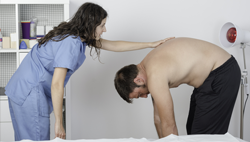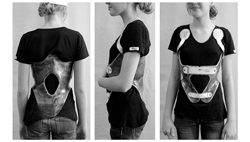All About Kyphosis Palos Hills and Mokena
Kyphosis is a spinal disorder in which an excessively curved spine results in an abnormal rounding of the upper back. A normal spine, when viewed from the side, is not a straight line. The thoracic portion of the spine has a normal forward curvature with a range of 20 to 50 degrees. The forward curvature of the spine is matched by reverse curvatures (called “sway”) in the neck (cervical spine) and lower back (lumbar spine), and this combination of forward and reverse curves allows people to sit and stand. The term “kyphosis,” drawn from the Greek term “kyphos” meaning “hump”, most commonly refers to excess curvature - greater than 50 degrees - of the upper back. Kyphosis can be identified in those with a noticeable, stooped-forward posture.
Kyphosis can develop at any age and affects both men and women. While this condition normally develops in the upper back, it is also possible to develop kyphosis in the lumbar or cervical spine. The majority of cases cause few problems and do not require serious treatment. In severe cases, kyphosis can be painful, cause significant spinal deformity and result in breathing difficulties. Patients may need surgery to help reduce spinal curvature and alleviate pain. (Spine Health)
Symptoms
Kyphosis symptoms range from mild to severe. Depending on the underlying cause of the condition, typical symptoms include:
- A hunched forward appearance, most pronounced when viewed from the side
- Mild to severe back pain
- Difficulty standing straight, worsening throughout the day
- A visible hump on the back
- Rounded shoulders
- Spine stiffness
- Fatigue
If a severe case of kyphosis goes untreated, symptoms may progress over time and may include:
- Weakness, numbness, or tingling in the legs
- Loss of sensation
- Shortness of breath due to compression of the lungs
- Loss of appetite. (Spine Health)
Types and Causes of Kyphosis
While there are many forms of kyphosis, the three forms of this condition that most commonly affect children and adolescents are:
Postural Kyphosis
Postural kyphosis is the most common type of kyphosis and usually becomes noticeable during adolescence. The condition is usually attributed to poor posture and slouching, but not associated with severe structural abnormalities of the spine. Postural kyphosis can usually be corrected with exercises to strengthen the abdominal and back muscles. This condition is rarely painful and usually does not lead to problems in adult life. OrthoInfo
Scheuermann’s Disease
This condition occurs in adolescence due to abnormal growth of spinal discs and is more common in boys than girls. The curve caused by Scheuermann’s kyphosis is usually sharp and angular, as well as stiff and rigid. Unlike postural kyphosis, this condition cannot be treated by simply correcting one’s posture.
Typically, this condition is treated with a back brace, exercise, and physical therapy. Bracing as a treatment method is applied to adolescent patients as a long-term, corrective effort, while it is rarely applied to adults where the goal is pain management rather than correction of the spine.
Specific exercises may be recommended to strengthen the abdominals and increase spinal flexibility. In cases where the spine is curved at 70 degrees or more, surgery may be required. This condition can sometimes be painful at the apex of the curve. Physical activity can worsen pain, as can long periods of standing or sitting. OrthoInfo
Congenital Kyphosis
Congenital kyphosis presents itself in infants and young children and occurs when the spinal column fails to develop normally while the baby is in utero, causing several vertebrae to fuse together. Congenital kyphosis worsens as the child ages, and unlike other forms of this condition, most often requires surgery at a young age to realign the spine and prevent progression of the deformity.
Treatment

A physician will begin with a physical examination, examining the patient’s back, pressing on the spine to determine if there are any areas of tenderness. During the exam, the physician will ask the patient to bend forward with their feet together, knees straight, arms hanging at their sides. This is called the “Adam’s forward bend test,” and enables physicians to better see the slope of the spine and any deformities that may be present.
Physicians will commonly request an X-Ray or MRI to determine if there are changes in the vertebrae or any other bone abnormalities. If a kyphotic curve is greater than 50 degrees, a physician may conduct a pulmonary function test to determine if a patient's breathing is restricted due to lung compression. OrthoInfo
Nonsurgical Treatment
There are a variety of nonsurgical treatment options for patients suffering from postural kyphosis and those with Scheuermann’s kyphosis who have less than a 75-degree curvature. Treatments may include:
- Observation - A physician may simply recommend monitoring the curve to make sure it does not progress negatively, or may schedule periodic visits and X-rays until the patient is fully grown.
- Physical Therapy - Specific exercises can help relieve back pain and improve posture by strengthening abdominal and back muscles. Certain exercises may be recommended to stretch tight hamstrings or strengthen other areas of the body negatively affected by the misalignment of the spine.
- Nonsteroidal Anti-inflammatory Drugs (NSAIDs) - Drugs including aspirin, ibuprofen and naproxen can help relieve back pain on a short-term basis.
- Bracing
![]()
For adolescent patients with Scheuermann's kyphosis, wearing a back brace may be recommended. The specific type of brace and length of duration depend on the severity of the curve. Typically, a brace is worn until the patient has reached skeletal maturity and growth is complete. (OrthoInfo/Image: Wikimedia Commons)
Surgical Treatment
For patients with severe cases of Scheuermann’s kyphosis, congenital kyphosis, or those who have not improved with nonsurgical treatment, surgery is an option.
The most common surgical procedure performed for kyphosis is spinal fusion, essentially a “welding process” to fuse together the affected vertebrae into a single, solid bone. Fusing vertebrae will reduce the degree of the curve because it eliminates motion between the affected vertebrae and may also alleviate back pain.
The goals of spinal fusion are to:
- Prevent further progression of the curve
- Reduce the degree of the curve
- Maintain improvement over time
- Alleviate as much back pain as possible
For specialized care, turn to MidAmerica. We can help reduce tissue trauma, postoperative pain, and expedite recovery time for conditions such as herniated discs, bone spurs, and kyphosis. While some post-surgery pain is to be expected, advancements in pain management and post-surgery physical therapy make it easier than ever to manage discomfort.
Postoperative Care

Spinal fusion surgery usually requires a hospital stay of one to two days. Pain is a natural part of the healing process and is to be expected post-surgery. The worst of the pain will diminish gradually over the course of four weeks, during which patients should not do any excessive lifting, bending or twisting. Patients with a back brace will be instructed to continue to wear the brace anywhere from six weeks to three months. After three months, patients may be prescribed a physical therapy routine to improve abdominal and spinal strength and restore flexibility.
At MidAmerica Orthopaedics, our post-surgery physical therapy and rehabilitation consists of recommended exercises and stretches, as well as training in proper bending and lifting techniques to avoid future injuries. Our regiments aim to get our patients back on their feet, returning to daily activities, and moving at the speed of life.
To learn more about MidAmerica Orthopaedics and the different treatment options available to you, visit our website.
To schedule an appointment with MidAmerica Orthopaedics, call (708) 237-7200, or request an appointment online.


